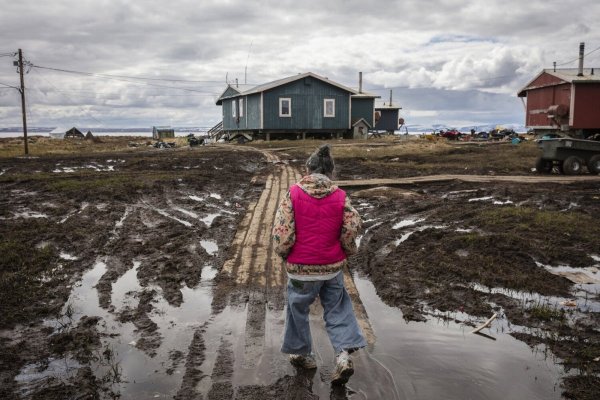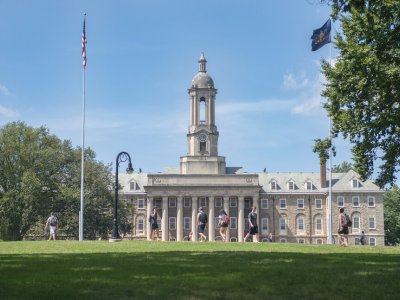The United Nations’ Intergovernmental Panel on Climate Change (IPCC) lists Good Health and Well-being (#3) and Reduced Inequalities (#10) among its top goals to combat social inequalities exacerbated by climate change (Bezner Kerr et.al. 2022). Indigenous people are the highest at-risk group for climate change impacts, like big storms and rising waters (Hutton & Allen, 2020) (Leonard, 2021). The National Oceanic and Atmospheric Administration predict that over the next 30 years, the sea level on the U.S. coast will rise an average of 10–12 inches, equaling the total sea level rise over the past 100 years. Inundation will be more severe, with typically damaging flooding occurring more than 10 times as much today (Sweet et al., 2022). These impacts have serious social ramifications for residents, complicated by existing socio-economic inequalities.
In the U.S., Native American tribes are particularly vulnerable to climate change impacts because of a history of ongoing colonial disenfranchisement (Bronen, 2010) (Hutton & Allen, 2020). Tribes have lost traditional subsistence practices, like fishing, hunting, and gathering, because of changing weather patterns (Maldonado et al., 2013). Additionally, tribes are restricted to reservation boundaries enforced by the United States government, unable to move from place to place for food and safety. After being forcibly displaced in the 19th century, Native American tribes often settled in environmentally vulnerable locations. Now, tribal communities are forced to relocate and rebuild their communities entirely or stay in locations of high sea level rise and flooding (Hutton & Allen, 2020) (Leonard, 2021).
Researchers and professionals are engaging with Indigenous communities seeking to adapt and respond to climate change (Hutton & Allen, 2020). However, establishing and maintaining community and tribal government trust can prove challenging to outsiders who do not have the same lived experience, place attachment, and cultural values as tribal members. The loss of trust can result in studies and adaptation plans that do not reflect tribes’ needs and waste public efforts, discouraging future collaboration.
Indigenous scholars and planners are identifying just strategies to combat climate change impacts and existing injustices (Leonard, 2021) (Maldonado et al., 2013) (Whyte, 2013). Justice-based frameworks help guide researchers, practitioners, and policymakers in collaborating with tribal members. The frameworks commonly include comprehensive public participation, Indigenous worldviews and cosmology, recognition of tribal sovereignty, and protection of tribal members (Leonard, 2021) (Maldonado et al., 2013) (Whyte, 2013). These frameworks can ensure a more equitable and representative collaboration process if elevated as standards in the academic and planning community.
However, there is a lack of spatial mapping documenting how sea level rise impacts vulnerable populations. This information is critical in understanding who is most impacted by current and future sea level rise and where they are located. We are currently exploring a nationwide spatial and statistical analysis of publicly available demographic and environmental data sets, including the U.S. CENSUS, NOAA (National Oceanic and Atmospheric), and EPA (Environmental Protection Agency). We utilize sea level rise scenarios of 1 foot (20–30 years), 2 feet (40–50 years), and 10 feet (100 years) to provide a comprehensive visual of inundation. This spatial data is combined with U.S. Census demographic data (race, sex, age, geographic mobility, and Gini Poverty Index) in ArcGIS Pro to locate vulnerable populations in areas of inundation.
We expect to find spatial evidence that supports existing case study research illustrating how underrepresented groups will be the most impacted by coastal inundation. However, suppose the data does not identify the communities we know to be impacted. In that case, it may provide evidence that large-scale, publicly available datasets fail to represent potentially at-risk groups of people. Either case will inform our work moving forward in drawing attention to at-risk groups and best practices for seeking out and engaging with such groups. This effort is a critical first step in locating vulnerable groups and describing barriers underrepresented Indigenous people face in adaptation decision-making.
Bezner Kerr, R. (2022). Climate Change 2022: Impacts, Adaptation, and Vulnerability. IPCC.
Bronen, R. (2010). Forced Migration of Alaskan Indigenous Communities Due to Climate Change. In T. Afifi & J. Jäger (Eds.), Environment, Forced Migration and Social Vulnerability (pp. 87–98). Springer Berlin Heidelberg. https://doi.org/10.1007/978-3-642-12416-7_7
Hutton, N. S., & Allen, T. R. (2020). The Role of Traditional Knowledge in Coastal Adaptation Priorities: The Pamunkey Indian Reservation. Water, 12(12), 3548. https://doi.org/10.3390/w12123548
Leonard, K. (2021). WAMPUM Adaptation framework: Eastern coastal Tribal Nations and sea level rise impacts on water security. Climate and Development, 1–10. https://doi.org/10.1080/17565529.2020.1862739
Maldonado, J. K., Shearer, C., Bronen, R., Peterson, K., & Lazrus, H. (2013). The impact of climate change on tribal communities in the US: Displacement, relocation, and human rights. Climatic Change, 120(3), 601–614. https://doi.org/10.1007/s10584-013-0746-z
Sweet, W.V., B.D. Hamlington, R.E. Kopp, C.P. Weaver, P.L. Barnard, D. Bekaert, W. Brooks, M. Craghan, G. Dusek, T. Frederikse, G. Garner, A.S. Genz, J.P. Krasting, E. Larour, D. Marcy, J.J. Marra, J. Obeysekera, M. Osler, M. Pendleton, D. Roman, L. Schmied, W. Veatch, K.D. White, and C. Zuzak (2022). Global and Regional Sea Level Rise Scenarios for the United States: Updated Mean Projections and Extreme Water Level Probabilities Along U.S. Coastlines. NOAA Technical Report NOS 01. National Oceanic and Atmospheric Administration, National Ocean Service, Silver Spring, MD, 111 pp. https://oceanservice.noaa.gov/hazards/sealevelrise/noaa-nostechrpt01-global-regional-SLR-scenarios-US.pdf
Whyte, K. P. (2013). Justice forward: Tribes, climate adaptation and responsibility. Climatic Change, 120(3), 517–530. https://doi.org/10.1007/s10584-013-0743-2
This article was originally on Medium (https://medium.com/@psuwaterstudentgroup/representing-indigenous-people-in-justice-based-frameworks-for-climate-change-adaptations-722deb3fb732) and was republished with permission.






